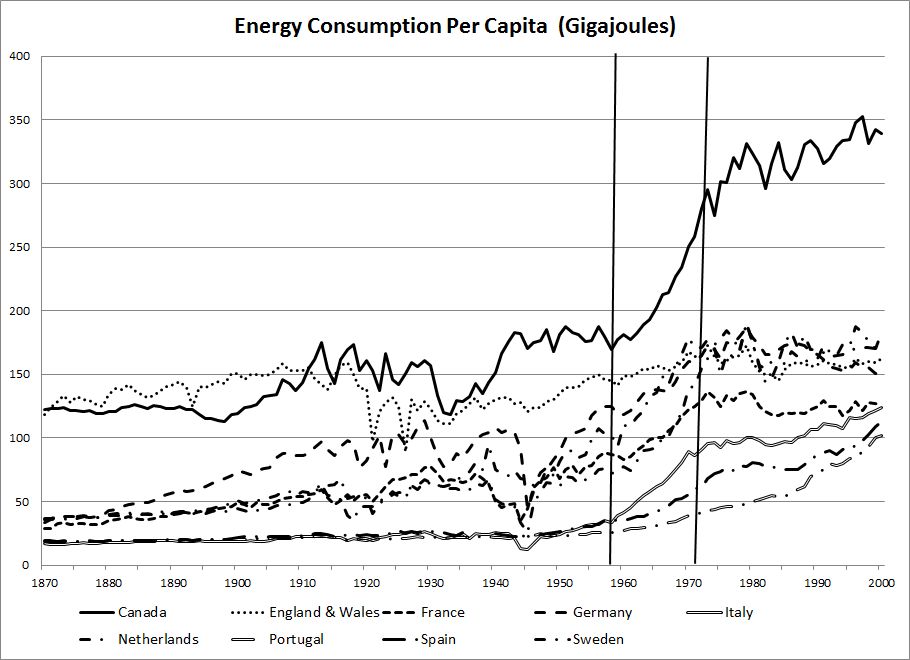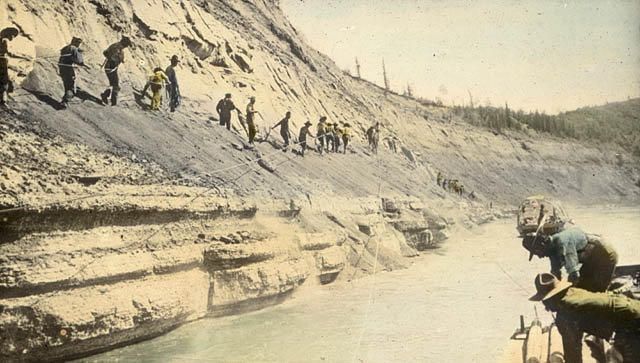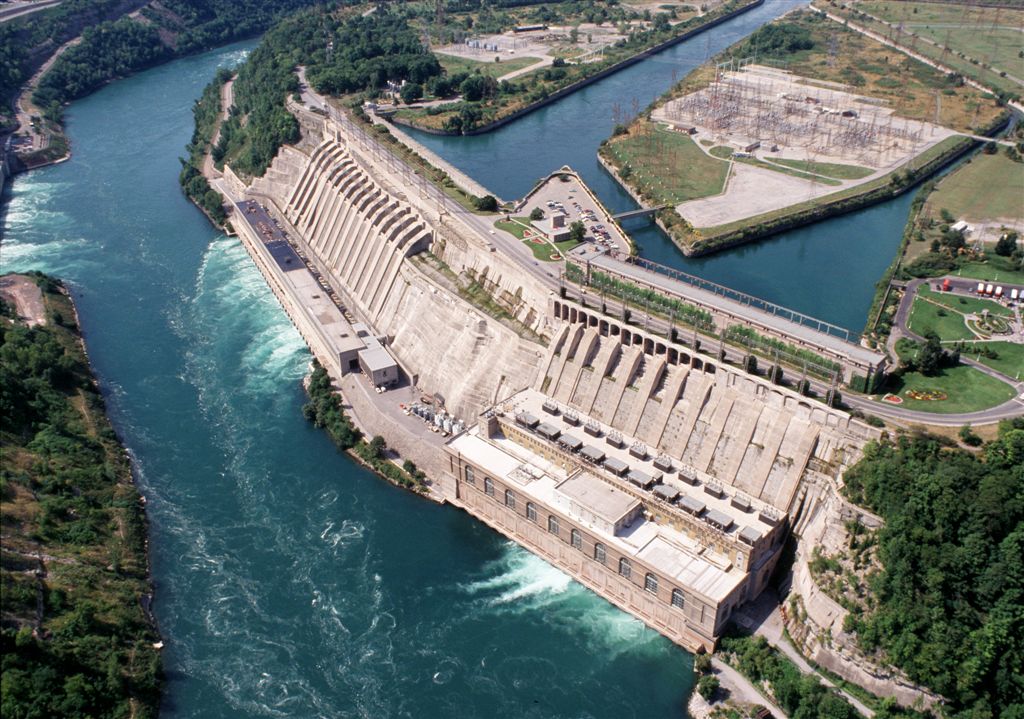Written by guest blogger, Richard W. Unger.
Canadians are among the greatest consumers of energy per person in the world. Iceland, with abundant geothermal sources and a small population, is the only country with a consistently higher level of energy use. Even the people in the United States fall behind Canadians in consuming energy. Those living in the ‘true North’ have been leaders on the planet for the last two centuries and probably even longer. Until the first decade of the twentieth century the majority of that energy came from fuelwood. Industrialization promoted a shift to fossil fuels. By 1903, coal supplied more energy than fuelwood. By 1955, oil exceeded coal as a source of energy. And by 1996, natural gas passed oil as an energy source for Canadians. In 2000, oil and natural gas provided almost equal amounts of energy while primary electricity, produced by wind or water power, supplied a bit more than half of either of the other two. That pattern of a series of shifts through fossil fuels was typical of countries in North America and western Europe over the last 150 years. Whatever the source, Canadians used a lot of energy.
 In 1983 Poste Canada Post issued a stamp as part of its Heritage Artifacts series of a woodstove, the principal device for consuming massive quantities of fuelwood in the nineteenth and for many years in the twentieth century. It joined items like skates, a decoy, a bucket and other humble household items that were part of daily life.
In 1983 Poste Canada Post issued a stamp as part of its Heritage Artifacts series of a woodstove, the principal device for consuming massive quantities of fuelwood in the nineteenth and for many years in the twentieth century. It joined items like skates, a decoy, a bucket and other humble household items that were part of daily life.
Energy consumption per person in Canada was already high compared to other jurisdictions in the world through the first half of the twentieth century. Surprisingly, and despite the established position of the country as a leader in energy consumption per person, people in Canada began to use considerably more through the 1960s. Between 1958 to 1973, per capita energy consumption in Canada rose 74 percent. Countries in Europe saw sharp rises in energy use starting in the 1950s. Many of them were recovering from the destruction of World War II and also from the massive disruption in their economies that were created by the war. It was also a period when the full force of the Industrial Revolution reached parts of southern Europe, where a more traditional and agrarian economy still dominated.
 Now the Adam Beck Hydroelectric Generating Stations in Niagara Falls, Ontario, uses waters from the Welland River to produce electricity for the provincial power grid. Subsequently expanded, when it opened in 1922 as the Queenston-Chippawa Hydroelectric Plant it was the largest hydroelectric generating station in the world. Canada remains among the few countries most reliant on falling water to produce electric power.
Now the Adam Beck Hydroelectric Generating Stations in Niagara Falls, Ontario, uses waters from the Welland River to produce electricity for the provincial power grid. Subsequently expanded, when it opened in 1922 as the Queenston-Chippawa Hydroelectric Plant it was the largest hydroelectric generating station in the world. Canada remains among the few countries most reliant on falling water to produce electric power.
While the increase in energy consumption in Europe during the 1960s is relatively easy to explain, the same cannot be said for what happened in Canada. In the same fifteen years that Canadians on average increased energy consumption 74 percent, consumption per person in Sweden rose at the same rate during a period of rapid economic growth in manufacturing and starting from a lower base. Sweden experienced the greatest increase among eight European states for which data are easily available – England and Wales together, France, Germany, Italy, the Netherlands, Portugal, Spain and Sweden. Over the same period, France saw a rise of just 58 percent and Germany, going through the Wirtschaftswunder, a considerably lower 43 percent. Canada was already well ahead of those countries in 1958. The gap widened in the 1960s despite the fact that the percentage rate of growth could be, in the extreme case of Sweden, similar. Canadians in 1958 were consuming 1.66 times as much energy as Swedes but in 1973 the figure was 1.71.
The growth in energy use in the years just before the first oil crisis came at a time when all countries were becoming more efficient, getting more value in the goods they produced from each unit of energy they used. It was part of a long-term trend throughout the twentieth century. Again, surprisingly, Canada was able in the same fifteen years from 1958 to 1973 to increase efficiency by some 7 percent while Sweden, increasing per capita consumption as much as Canada, saw almost no improvement in efficiency.
 The Athabasca Tar Sands in Alberta, known since the eighteenth century, have long been thought a potential source of petroleum. Efforts like those shown here between 1900 and 1930 to exploit the abundant reserves proved futile. Technological advances and rising oil prices only made that possible in the latter years of the twentieth century. Library and Archives Canada, 3592868.
The Athabasca Tar Sands in Alberta, known since the eighteenth century, have long been thought a potential source of petroleum. Efforts like those shown here between 1900 and 1930 to exploit the abundant reserves proved futile. Technological advances and rising oil prices only made that possible in the latter years of the twentieth century. Library and Archives Canada, 3592868.
The comparison of what happened in Canada with what happened in other countries is the topic of my article “Shifting Energy Sources in Canada: An International Comparison, 1870-2000,” recently published in the Canadian Journal of History special issue on the Material Realities of Energy History. This comparison can reveal a great deal about anomalies, as well as what was important to Canada’s pattern of energy use. Laying the data side-by-side reveals differences and suggests where it might be possible to identify distinct features as well as causes of changes within the energy economy of the country. The changing suppliers of energy, and their relative importance over time, has always had an impact on the environment. Comparisons can point to the sensitive times when those shifts took place and so offer indications of where and when to look for the role of final energy users in shaping the landscape. With eight different European countries with different climates and histories there are benchmarks against which to measure what happened in Canada. While the comparisons point to differences that set each of the political units apart, it proves hard to explain why those differences have appeared and why they may have persisted.
 In the years from 1958 to 1973 energy consumption in Canada moved rapidly higher, extending even more its lead over eight European countries which were enjoying rapid economic growth in those years. See text.
In the years from 1958 to 1973 energy consumption in Canada moved rapidly higher, extending even more its lead over eight European countries which were enjoying rapid economic growth in those years. See text.
When looking at energy use, Canada is similar to many European countries but different in other ways. The comparison points to questions about the energy history of Canada that could yield productive and informative research. The strange drive in Canada during the 1960s to surge even further ahead of European countries in using fossil fuels, even when those European countries were themselves sharply increasing their energy consumption, is just one anomaly that sets Canada apart. Many possible explanations come to mind, yet preliminary and straightforward tests of the obvious reasons do not yield expected results. It is hard to establish why Canada was different. The preliminary investigation of some of the most obvious explanations such as the nature of climate, different resource endowment, levels of incomes per person in the article yield mixed results. Reasons for different patterns of energy consumption may well be complex. There are many other questions to test that emerge almost automatically from looking at Canada’s energy history in light of what went on elsewhere. Finding answers to those questions offers the potential for extensive productive research for anyone willing to take on the task.
Banner: Horsepower replaced gasoline-powered engines during the worst years of the Great Depression. Called Bennett buggies after the prime minister, R. B. Bennett, this one is crossing the campus of the University of Saskatchewan in about 1935.
Richard W. Unger is Professor Emeritus in the Department of History, University of British Columbia. His work has concentrated on the economy of pre-modern Europe, principally of the shipping and brewing sectors, as well as Canadian energy consumption. Read his article in the latest issue of CJH, “Shifting Energy Sources in Canada: An International Comparison, 1870–2000”—free for a limited time here.

Comments on this entry are closed.